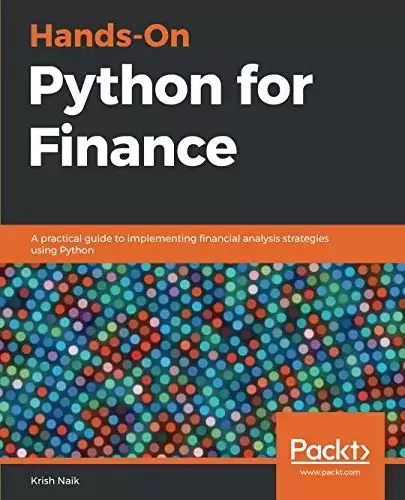
Book Description
Learn and implement quantitative finance using popular Python libraries like NumPy, pandas, and Keras
Key Features
- Understand Python data structure fundamentals and work with time series data
- Use popular Python libraries including TensorFlow, Keras, and SciPy to deploy key concepts in quantitative finance
- Explore various Python programs and learn finance paradigms
Book Description
Python is one of the most popular languages used for quantitative finance. With this book, you’ll explore the key characteristics of Python for finance, solve problems in finance, and understand risk management.
The book starts with major concepts and techniques related to quantitative finance, and an introduction to some key Python libraries. Next, you’ll implement time series analysis using pandas and DataFrames. The following chapters will help you gain an understanding of how to measure the diversifiable and non-diversifiable security risk of a portfolio and optimize your portfolio by implementing Markowitz Portfolio Optimization. Sections on regression analysis methodology will help you to value assets and understand the relationship between commodity prices and business stocks. In addition to this, you’ll be able to forecast stock prices using Monte Carlo simulation. The book will also highlight forecast models that will show you how to determine the price of a call option by analyzing price variation. You’ll also use deep learning for financial data analysis and forecasting. In the concluding chapters, you will create neural networks with TensorFlow and Keras for forecasting and prediction.
By the end of this book, you will be equipped with the skills you need to perform different financial analysis tasks using Python
What you will learn
- Clean financial data with data preprocessing
- Visualize financial data using histograms, color plots, and graphs
- Perform time series analysis with pandas for forecasting
- Estimate covariance and the correlation between securities and stocks
- Optimize your portfolio to understand risks when there is a possibility of higher returns
- Calculate expected returns of a stock to measure the performance of a portfolio manager
- Create a prediction model using recurrent neural networks (RNN) with Keras and TensorFlow
Who this book is for
This book is ideal for aspiring data scientists, Python developers and anyone who wants to start performing quantitative finance using Python. You can also make this beginner-level guide your first choice if you’re looking to pursue a career as a financial analyst or a data analyst. Working knowledge of Python programming language is necessary.
Table of Contents
- Python for Finance 101
- Getting started with Numpy, Pandas and Matplotlib
- Time Series Analysis and Forecasting
- Measuring Investment Risks
- Portfolio Allocation and Markowitz Portfolio Optimization
- The Capital Asset Pricing Model
- Regression Analysis in Finance
- Monte Carlo simulations for decision-making
- Option Pricing-Black Scholes Model
- Introduction to Deep Learning with TensorFlow and Keras
- Stock Market Analysis and Forecasting Case study
- What Is Next
中文:
书名:金融领域的实战巨蟒
使用流行的Python库(如NumPy、Pandas和Kera)学习和实施量化金融
主要特点
- 了解Python数据结构基础知识并使用时间序列数据
- 使用流行的Python库(包括TensorFlow、Kera和SciPy)部署量化金融中的关键概念
- 探索各种Python程序并学习金融范例
图书描述
Python是用于量化金融的最流行的语言之一。在这本书中,您将探索适用于金融的Python的关键特性,解决金融中的问题,并了解风险管理。
这本书首先介绍了与量化金融相关的主要概念和技术,并介绍了一些关键的Python库。接下来,您将使用Pandas和DataFrames实现时间序列分析。以下章节将帮助您了解如何衡量投资组合的可分散和不可分散的安全风险,并通过实施Markowitz投资组合优化来优化您的投资组合。回归分析方法的章节将帮助你评估资产价值,并理解大宗商品价格和商业股票之间的关系。除此之外,你还将能够使用蒙特卡洛模拟来预测股票价格。这本书还将重点介绍预测模型,这些模型将向您展示如何通过分析价格变化来确定看涨期权的价格。您还将使用深度学习进行财务数据分析和预测。在最后一章中,您将使用TensorFlow和Kera创建用于预测和预测的神经网络。
在本书结束时,您将掌握使用Python执行不同金融分析任务所需的技能
What you will learn
- 使用数据预处理清理财务数据
- 使用直方图、颜色图和图表可视化财务数据
- 对熊猫进行时间序列分析以进行预测
- Estimate covariance and the correlation between securities and stocks
- 当有可能获得更高回报时,优化你的投资组合以了解风险
- 计算股票的预期收益来衡量投资组合经理的表现
- 使用递归神经网络(RNN)和Kera和TensorFlow创建预测模型
Who this book is for
这本书是有抱负的数据科学家、Python开发人员和任何想要开始使用Python执行量化金融的人的理想选择。如果你想成为一名金融分析师或数据分析师,你也可以把这本初学者级别的指南作为你的首选。必须具备Python编程语言的工作知识。
Table of Contents
- Python for Finance 101
- Getting started with Numpy, Pandas and Matplotlib
- 时间序列分析与预测
- Measuring Investment Risks
- 投资组合配置与Markowitz投资组合优化
- The Capital Asset Pricing Model
- Regression Analysis in Finance
- 决策的蒙特卡罗模拟
- 期权定价–布莱克-斯科尔斯模型
- 基于TensorFlow和KERS的深度学习简介
- 股票市场分析与预测案例研究
- 下一步是什么
评论前必须登录!
注册